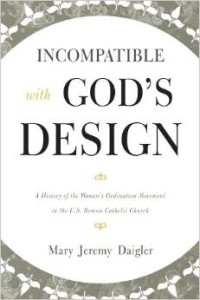Book Review: Incompatible with God’s Design: A History of the Women’s Ordination Movement in the U.S. Roman Catholic Church
Mary Jeremy Daigler. Incompatible with God’s Design: A History of the Women’s Ordination Movement in the U.S. Roman Catholic Church. Lanham, MA: Scarecrow Press, 2012. 199 pp., appen., biblio., index. ISBN 978-0-8108-8479-3. $75.00.
There was a time in my life when I devoured every article and book on women’s ordination. I was passionate about every aspect of the issue. Those intense feelings waned over the past decade or so as I moved on to understand and live out my priesthood in different ways. Yet over the years I wondered if I’d ever experience that intensity again. To my surprise, reading Daigler’s book brought back that excitement for me. This is a rigorous and thoroughly researched history of the movement that will be required reading for anyone who wants or needs to be informed on our movement as well as a good read.
Incompatible with God’s Design is a page-turner filled with personal stories and drama and yet it is also balanced with the keen insight and reporting of a seasoned historian. Daigler is a good storyteller yet she is also able to recount historical events and characters without casting her emotions or judgments that could sway even the most dispatched writer or academic.
The book lays out its subject matter as if weaving a tapestry. Daigler chooses as her theme “design” as in God’s careful creation and each chapter develops that masterpiece with matching titles—“Illuminating a Design,” “Braid,” “Mosaic,” “Circles,” “Cross,” “Centripetal Lines,” and “Upward Spiral.”
In each chapter the author moves us through history. She begins with the St Joan’s International Alliance in 1911 in England, to our foremothers here in the States with the story of Mary Lynch, the beginning of WOC, and the tireless and generous work of many disciples—women and men alike. Daigler traces the pre- and post-Vatican II eras, the role of women religious in the movement; organizational stitches and seams; the Vatican teachings and how they were promulgated; international influences—with lots of detailed examples of the movement across the globe; all the way up to the current time, spreading out the quilt of challenges and hurdles still needing to be conquered.
Many workers of the movement are introduced and given names, places, dates, and the groups they were part of; how they understood women’s roles in the church, and how they went about forging the movement. Daigler is also a capable sociologist as she details the attitudes, cultures, and ethos to which each group subscribed and how they understood the burgeoning movement. Few stones are unturned and the countless people who worked in the movement are given place and stature, including many male clergy who were supportive in the Vatican II and post-Vatican II days. It will be astonishing to many young women who read this book as they will discover that there were so many prominent clerics who were interested, involved, truly supportive of women’s ordination, and, equally telling, they seemed unafraid.
The title of the book comes from a document of the Second Vatican Council, Gaudium et Spes (Church in the Modern World), specifically article 29: “Every form of social or cultural discrimination in fundamental personal rights on the grounds of sex, race, color, social condition, language or religion must be curbed and eradicated as incompatible with God’s design” (emphasis mine). Daigler draws out that design and show precisely over and over and over precisely what needs to be curbed and eradicated.
For readers wanting to scour important sources, Daigler offers some apt appendices: Mary Lynch and Aileen Murphy’s dedication ceremony to the movement; Theresa Kane’s Welcome to Pope John Paul II; the family tree of the women’s ordination movement; and other archival collections. These appendices offer a budding women’s ordination scholar ample back- ground for any serious paper or thesis on the topic.
The women’s ordination movement owes a great debt of gratitude to Mary Jeremy Daigler for this magnum opus. She has put in writing the definitive story that needed to be told. Our other good fortune is that Daigler wrote this book to not only honor those early disciples of the women’s ordination movement in the United States but she also hands over the mantle to the next generation of leaders who are also deftly carry- ing on this important work.
Diana Wear has been an editor for WOC’s New Women, New Church newsletter for over a decade and a half. She writes for us from Richmond, Calif. This article first appeared in New Women, New Church in Spring/Summer 2013, vol. 36 n. 1.

